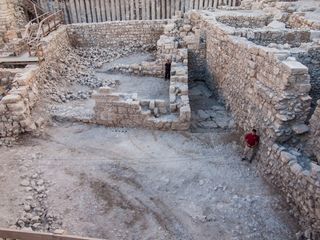City of David Discovery Fills Gap in Jerusalem History

Archaeologists have discovered the first ruins of a building from the Hasmonean period in Jerusalem, filling a gap in the ancient city's history, the Israeli Antiquities Authority (IAA) announced.
The building's remains were uncovered during an extensive dig at the Givati Parking Lot, located in Jerusalem's oldest neighborhood, the City of David. Excavations over several years at the site have turned up some remarkable finds, including a building from the Second Temple period that may have belonged to Queen Helene, a trove of coins from the Byzantine period, and recently, a 1,700-year-old curse tablet in the ruins of a Roman mansion.
Despite extensive excavations in Jerusalem, IAA archaeologists Doron Ben Ami and Yana Tchekhanovets said there has been an absence of buildings from the Hasmonean period in the city's archaeological record. Simon Maccabeus founded the Hasmonean dynasty in 140 B.C. This group ruled Judea until 37 B.C., when Herod the Great came into power. [In Photos: The Controversial 'Tomb of Herod the Great']
"Apart from several remains of the city's fortifications that were discovered in different parts of Jerusalem, as well as pottery and other small finds, none of the Hasmonean city's buildings have been uncovered so far, and this discovery bridges a certain gap in Jerusalem's settlement sequence," excavators Doron Ben Ami and Yana Tchekhanovets said in a statement. "The Hasmonean city, which is well-known to us from the historical descriptions that appear in the works of Josephus, has suddenly acquired tangible expression."
Flavius Josephus recounted Jewish history and the Jewish revolt against the Romans in his first century A.D. books "The Jewish War" and "Antiquities of the Jews." Some archaeologists have used his texts to guide their work and interpretations. For example, excavators who recently found cooking pots and a lamp in an underground chamber in Jerusalem think these objects could be material evidence of Josephus' account of famine during the Roman siege of the city.
IAA officials said the Hasmonean building has only come to light in recent months, adding that the structure boasts quite impressive dimensions. It rises 13 feet (4 meters) and covers 688 square feet (64 square meters) with limestone walls more than 3 feet (1 m) thick.
Inside, the excavators found pottery and coins, the latter of which helped them determine the age of the building. IAA researchers think construction on the building began in the early second century B.C. and continued into the Hasmonean period, when the most significant changes were made inside the structure.
Sign up for the Live Science daily newsletter now
Get the world’s most fascinating discoveries delivered straight to your inbox.
Follow Megan Gannon on Twitter and Google+. Follow us @livescience, Facebook & Google+. Original article on LiveScience.

